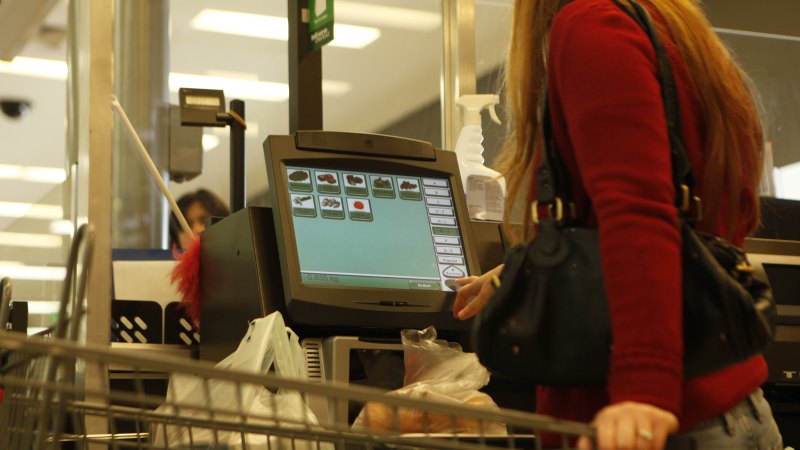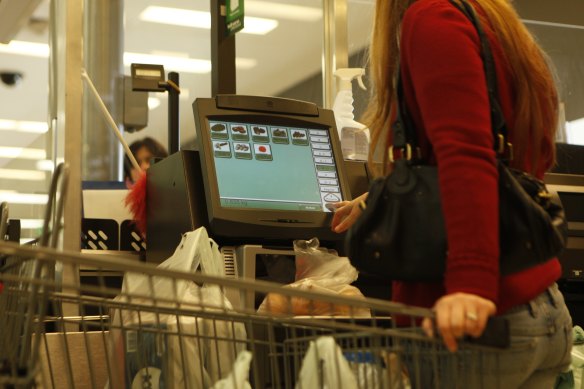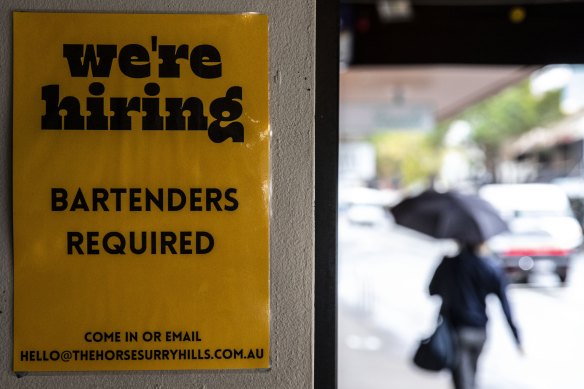Jobs market slips as consumers struggle to make ends meet

Save articles for later
Add articles to your saved list and come back to them any time.
The jobs market and retail sector are deteriorating under the weight of the Reserve Bank’s aggressive interest rate rises and inflation, with figures revealing households are running down their bank deposits to deal with the high cost of living.
Ahead of new RBA governor Michele Bullock’s first meeting in charge of the central bank, data from the Australian Bureau of Statistics showed one of the largest quarterly drops in job vacancies this century and the first fall in the cash held by households in 16 years.
Consumers are struggling to fill their shopping trolleys as higher interest rates and inflation bite into their spending habits.Credit: Fairfax
According to the bureau, retail sales increased by a much lower than expected 0.2 per cent in August, to be up by just 1.5 per cent over the past 12 months. Once inflation and population growth are taken into account, real retail spending continues to fall.
Australians spent less in August than they did in November last year, when the Reserve Bank took official interest rates to 2.85 per cent. The cash rate is now at 4.1 per cent.
Spending on clothing and footwear and through cafes and restaurants lifted in August, which some economists put down to the impact of the FIFA Women’s World Cup.
Separate figures from the bureau showed an 8.9 per cent drop in the number of job vacancies across the country through the three months to August. The disappearance of 38,000 vacancies over the quarter was the largest this century, excluding the early stages of the COVID-19 pandemic.
It was driven by a 9.2 per cent decline in the number of jobs advertised in the private sector, which have now fallen by more than 16 per cent over the past year.
Vacancies peaked at a record 476,900 in May last year, the same month the Reserve Bank started to lift interest rates from their low of 0.1 per cent. They have now fallen by 18.1 per cent.
The health sector, the nation’s largest employer, continues to post the most job vacancies, with more than 68,000 positions needing to be filled. Total health-related vacancies are little changed from where they were in May last year.
But vacancies in the property sector, finance, transport, IT and construction have all fallen sharply since the Reserve Bank started lifting interest rates.
Falls in vacancies are normally associated with a lift in the unemployment rate, which in August reached 3.7 per cent while the underemployment rate also increased.
As job vacancies decline and retail spending falls, consumers are now digging into their savings to make ends meet.
Household wealth, as measured by the bureau, climbed in the June quarter by 2.6 per cent, or $379 billion, to $15.1 trillion. Of that increase, 80 per cent was driven by a lift in the value of the nation’s homes and land while the rest was due to improvement in superannuation balances.
But the figures also revealed households reduced their holdings of cash, either in their wallets or bank deposits, by $6.3 billion. It was the first fall in cash holdings – which soared by more than a third through the pandemic – since early 2007, when Australians were dealing with high inflation.
Job vacancies have fallen by 18 per cent since the Reserve Bank started lifting interest rates.Credit: Jessica Hromas
St George senior economist Pat Bustamante said the figures suggested the Reserve Bank’s interest rate rises might bite even more deeply.
“Elevated cost-of-living pressures and higher interest rates are putting pressure on household budgets and households have had to dip into deposits,” he said.
The figures are on top of this week’s inflation data, which showed a petrol-driven increase in the monthly consumer price index through August. All will be assessed when the Reserve Bank board meets on Tuesday.
KPMG chief economist Brendan Rynne said the continuing sluggishness of the retail sector on top of the impact of higher petrol prices on consumers meant aggregate demand across the economy was ebbing.
“The broad impact of high fuel prices, combined with weak retail sales would seem to indicate a further rate pause on Tuesday,” he said.
Cut through the noise of federal politics with news, views and expert analysis. Subscribers can sign up to our weekly Inside Politics newsletter.
Most Viewed in Politics
From our partners
Source: Read Full Article

